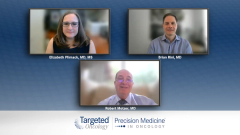
4-Year Follow-Up Results of Lenvatinib Plus Pembrolizumab in Frontline aRCC
Panelists analyze the 4-year follow-up results of the CLEAR study, covering study design, efficacy, safety, and clinical implications.
Episodes in this series

Dr. Robert Motzer: The other thing is, is that I think was very impressive was the- has been the results of the longer follow-up with the CLEAR study that was reported and presented by Tom Hudson at the ASCO meeting. And the- for that study that was a three arm trial, that compared len pembro versus sunitinib, and len eve versus sunitinib. The primary endpoint was reached for len pembro and len eve over sunitinib, but the results were much more promising and impressive with len pembro. There was a benefit in progression free survival and in survival as well. And given the toxicity with len eve and the fact that the survival was- the benefit was not achieved, the- it was really the len pembro that moved ahead. So we- the results were presented side by side with the long term results with the axi pembro versus sunitinib data at ASCO. And they showed that the- continue to show a durable benefit in overall survival with a hazard ratio of 0.79 in favor of len pembro. Progression free survival, again, durable with the longest median progression free survival that we've seen in any study in RCC. And a very impressive response rate over 70% with nearly a 20% CR rate. So I think that that study in particular, as well as the longer follow-up that Brian may want to comment on with the axi pembro has really impressed me with the TKI IO combinations in terms of their outstanding efficacy.
Dr. Brian Rini: I can just jump in. I agree. I think that ASCO updates number one, are very important. So kudos to the company for- companies for doing it, and I hope they continue to do it. Not just three, four, five, but six, seven, eight, nine, 10. And I think that's incumbent upon all the regimens and all the trials to do that because it is important, especially talking to patients. Yes, not to diminish short term outcomes, but patients want a number of, hey, doc, what's my chance of being alive at five years. What's my chance of remission, durable response, however we want to term it at three, five, seven years. So I think those numbers, especially the long term numbers give patients hope. I know I use them in practice fairly routinely on day one when it's a little overwhelming for people. But I think both the CLEAR update and the 426 updates sort of reaffirm the short term results and start to build a case around a subset of patients having a durable response. So the tail, if you will, of the axi pembro PFS curve at five years looks to be about 20%. And there's all sorts of caveats around censoring and the tail, and this, and I- we don't want to go down those rabbit holes. But if you just sort of take the numbers at face value, I think there is a tail. It certainly needs more follow up, but I think we're starting to see that durable effect. And then the other thing I'll mention that we presented at ASCO was the completer analysis. So as you all know, in the IO TKI regimens, the IO stopped at two years or 35 doses in all patients who were on at that point, of course. And it was about 28% of patients on axi pembro. Betsy, you actually initially presented this at ASCO GU last year, maybe. And so we updated, it was 28% of patients who made it to 35 doses. So that's a pretty good chunk of patients, nearly a third of patients making it out to that two year mark. When we looked at the characteristics of those patients, not surprisingly, they were a little more favorable, a little less bulky disease, a little less sites of metastases, and quite obviously a very high response rate, 85% of patients in that group had responded. Not surprisingly, but I was kind of struck that 70% were alive at that five year mark, and I think it was like 35% or something were progression free. So quite obviously that's the best of the best. You're skimming off the patients who are alive and doing well at two years. But I'm having a lot of those conversations now in clinic. I'm getting a lot of patients on off protocol axi pembro or whatever, who are getting to that two year mark. And I find those data fairly reassuring that they're not progressing rapidly, that they can have durable response. Many are continuing TKI, but not all. We haven't looked at that in 426, but in my practice, I have some patients who have previously stopped TKI or want to stop, and I'm just starting to sort of get some experience with patients on no drugs from these IO TKI regimens. I thought that was an important, it wasn't a primary endpoint, but I thought it was an important subset, if you will, to look at, and again, I think useful in counseling patients.
Dr. Robert Motzer: And I think the other thing that's reassuring is now we have really three large phase three trials showing with TKI IO combinations, with PD-1 inhibitors at least, that are both really showing comparable results with regard to efficacy. A very high response rate, very low proportion of patients who have progression of disease, improvement in progression free survival and overall survival. So I think it really to me confirms that we're kind of on the right track with the approach.






































